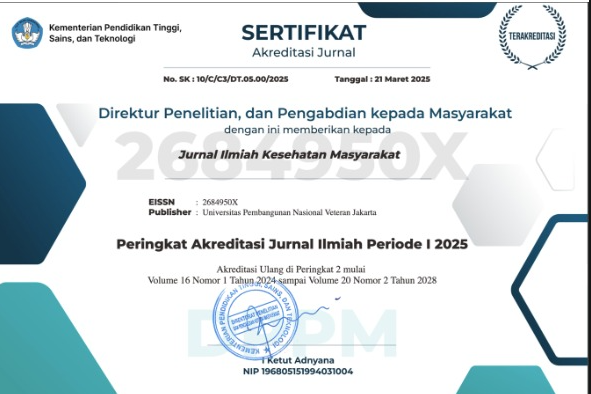Produktivitas Kerja Saat Work From Home (WFH) dan Work From Office (WFO) pada Dosen FKM Universitas Mulawarman di Masa Pandemi Covid-19
Abstract
Abstrak
Latar Belakang: Virus corona yang terus meningkat menyebabkan sekolah dijalankan secara Work From Home (WFH) dengan online. Produktivitas kerja menjadi suatu permasalahan jika pekerja bekerja di rumah, termasuk seorang dosen.
Tujuan: Penelitian ini bertujuan mengetahui perbedaan produktivitas kerja pada saat Work From Home (WFH) dan Work From Office (WFO) dimasa Pandemi.
Metode: Desain penelitian ini adalah cross sectional yang berjenis kuantitatif. Jumlah populasi sebanyak 31 tenaga kependididkan dan dosen dengan teknik sampel yaitu total sampling. Analisis data yang digunakan ialah analisis univariat, bivariat dengan uji Wilcoxon Sign Rank Test dengan tingkat kepercayaan sebesar 95%.
Hasil: Hasil analisis menggunakan uji wilconxon signed rank test didapatkan nilai sig sebesar 0.219 > 0.05 yang berarti H0 diitolak.
Kesimpulan: Tidak ada perbedaan produktivitas kerja pada tenaga kependidikan dan dosen pengajar Fakultas Kesehatan Masyarakat Universitas Mulawarman pada saat Work From Home (WFH) dan Work From Office (WFO) di masa pandemi.
Work Productivity Differences in Education and Teachers of Faculty of Public Health when WFH (Work From Home) and WFO (Work From Office) at FKM Lectures of Mulawarman University during Pandemic
Abstract
Background: The corona virus which continues to increase causes schools to run online as WFH (Work From Home). Various problems arise due to the rules for lecturers to teach at home, one of which is the productivity of the lecturers.
Purpose: This study aims to determine the differences in work productivity during WFH (Work From Home) and WFO (Work From Office) during the Pandemic.
Methods: The design of this study was a cross sectional quantitative type. The total population was 31 education staff and lecturers with the sampling technique using the total sampling technique. The data analysis used was univariate, bivariate analysis with the Wilcoxon Sign Rank Test with a confidence level of 95%.
Results: The results of the analysis using the Wilcoxon signed rank test obtained a sig value of 0.219> 0.05, which means that H0 is rejected.
Conclusion: There was no difference in work productivity among teaching staff and lecturers at the Faculty of Public Health, Mulawarman University during the Work From Home (WFH) and Work From Office (WFO) during the pandemic.
References
Parlementaria. tangkal covid-19, Pemerintah harus tingkatkan sinergi. DPR RI. 2020;8.
Mungkasa O. Bekerja dari Rumah (Working From Home/WFH): Menuju Tatanan Baru Era Pandemi COVID 19. J Perenc Pembang Indones J Dev Plan. 2020;4(2):126–50.
Simarmata RM. Pengaruh Work From Home terhadap Produktivitas Dosen Politeknik Negeri Ambon. J Ekon Sos Hum. 2020;02(01):73–82.
United Nations Educational S and CO. School closures caused by Coronavirus (Covid-19). Unesco. 2020.
Hertanto E. (6) (DOC) Kuesioner Kepuasan Kerja Karyawan (Model Robbins & Judge) _ Eko Hertanto - Academia. 2017.
Mulawarman SU. Daftar Rekapitulasi PNS Tenaga Pengajar Universitas Mulawarman. Unmul. 2020.
Wilder-Smith A, Freedman DO. Isolation, quarantine, social distancing and community containment: Pivotal role for old-style public health measures in the novel coronavirus (2019-nCoV) outbreak. J Travel Med. 2020;27(2):1–4.
Crosbie T, Moore J. Work–life Balance and Working from Home. Soc Policy Soc. 2004;3(3):223–33.
Singh MK, Kumar V, Ahmad T. Impact of Covid-19 Pandemic on Working Culture: An Exploratory Research Among Information Technology (IT) Professionalsin Bengaluru, Karnataka (India). SSRN Electron J. 2020;12(5):3176–84.
Duta Mustajab, Azies Bauw, Abdul Rasyid, Andri Irawan*, Muhammad Aldrin Akbar & MAH. Fenomena Bekerja dari Rumah sebagai Upaya Mencegah Serangan COVID-19 dan Dampaknya terhadap Produktifitas Kerja. J Chem Inf Model. 2020;4(9):1689–99.
Purwanto A. Studi Eksplorasi Dampak Work From Home ( WFH ) Terhadap Kinerja Guru Selama Pandemi Covid-19. J Educ Psychol Couns. 2020;2(1):1–12.
Erliana cut tari. Bahan Ajar Analisa dan Pengukuran Kerja. Bukit Indah; 2015.









.jpg)








